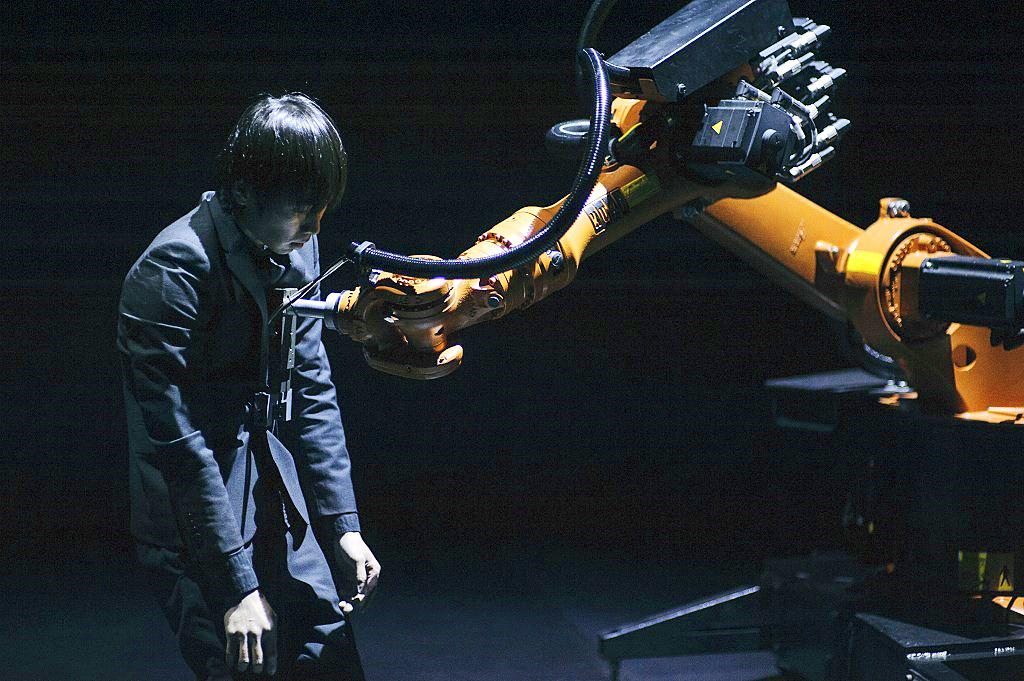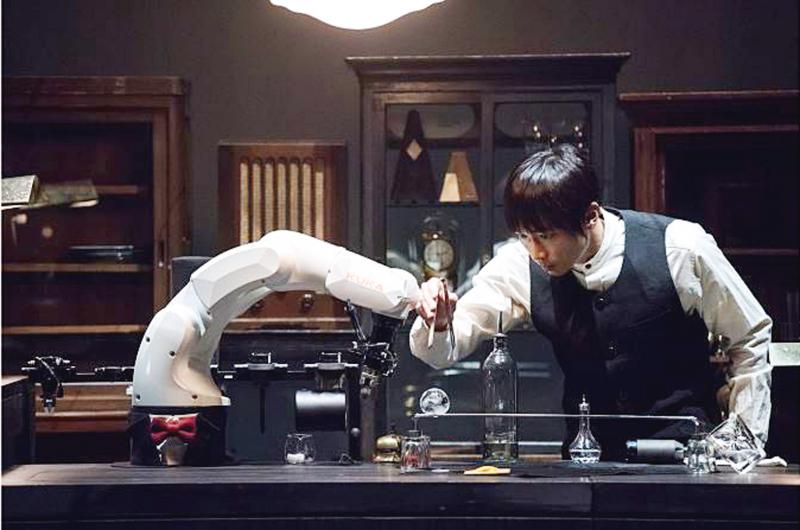After creating works involving robots for over a decade, choreographer Huang Yi (黃翊) is set to present his latest work in the spring in the form of a coffee shop set in the future.
In the upcoming production Little Ant & Robot: A Nomad Cafe, Huang further develops his dream of having robots and dancers perform together and interact with the audience, the choreographer said.
“The coffee shop is set in the future. I have been wondering about the possible interactions between people, as well as people and robots ever since I was little,” he said. “It should not be about technology replacing people in more and more areas,” said Huang, who envisages a harmonious relationship between people and robots, in which they help and support each other.

Photo: CNA
Huang, who is also a coder, first contacted German automation solution provider KUKA Robotics in 2010 and created Huang Yi & KUKA in 2012, in which he danced with a pre-programmed robotic arm that was over two meters in length.
The 2012 production has since been performed 78 times in 32 cities and 17 countries.
For his new production, which is scheduled to premiere at the National Theater in Taipei on April 23 before touring Taiwan through July, Huang uses a smaller 50-centimeter tall KUKA model.

Photo: CNA
KUKA will be programmed to serve coffee and dessert, interact with dancers, and use a drumstick to play rhythm, with some performances designed for families and children, said Huang.
Despite the fact that he is not a coffee drinker, his new work is set in a cafe and revolves around the drink — an important element in the lives of people he collaborates with — focusing on incorporating daily life into a dance piece, Huang said.
“It will be as if people can download fond memories here. There will be moments of people meeting with each other, parting, celebrating, as well as times of happiness, which are ‘saved’ in this work and can be played again and again like memories,” he said.
Apart from KUKA’s more detailed and intricate movements, Huang also mentioned the progress he is making with the new production.
“I’m very pleased that this time it is not just me writing the program,” he said, noting how every member of the production is more involved in the creative process.
For instance, one of the dancers is in charge of all technical aspects of the production, as well as designing the robot’s automation.
Huang also thanked Cloud Gate Dance Theatre founder Lin Hwai-min (林懷民) for his support, giving him lots of space and asking questions that helped clarify his ideas and taught him to be practical.
Given Lin is about 35 years his senior, Huang, who is in his late 30s, is also thinking about the role he can play for future artists, who he said are perhaps still babies now.
Huang believes 35 years is just about the time needed for an artist to make a major breakthrough in both the arts and technology.
“Then I can offer more substantial assistance,” he said, “the person [who would have my assistance] could be Taiwanese or a foreigner. I’ll wait for the individual to come to see a performance and to grow up.”
“I’ll encourage that person to have a unique voice, to contribute to the industry and to create art for his/her generation,” he said.
Little Ant & Robot: A Nomad Cafe will be staged at the National Theater April 23 to April 25, before moving to Songshan Cultural and Creative Park in Taipei for a month-long presentation in a more intimate setting in May.
The production will then move to the National Taichung Theater June 4 to June 6 and the National Kaohsiung Center for the Arts July 10 to July 11.

That US assistance was a model for Taiwan’s spectacular development success was early recognized by policymakers and analysts. In a report to the US Congress for the fiscal year 1962, former President John F. Kennedy noted Taiwan’s “rapid economic growth,” was “producing a substantial net gain in living.” Kennedy had a stake in Taiwan’s achievements and the US’ official development assistance (ODA) in general: In September 1961, his entreaty to make the 1960s a “decade of development,” and an accompanying proposal for dedicated legislation to this end, had been formalized by congressional passage of the Foreign Assistance Act. Two

Despite the intense sunshine, we were hardly breaking a sweat as we cruised along the flat, dedicated bike lane, well protected from the heat by a canopy of trees. The electric assist on the bikes likely made a difference, too. Far removed from the bustle and noise of the Taichung traffic, we admired the serene rural scenery, making our way over rivers, alongside rice paddies and through pear orchards. Our route for the day covered two bike paths that connect in Fengyuan District (豐原) and are best done together. The Hou-Feng Bike Path (后豐鐵馬道) runs southward from Houli District (后里) while the

March 31 to April 6 On May 13, 1950, National Taiwan University Hospital otolaryngologist Su You-peng (蘇友鵬) was summoned to the director’s office. He thought someone had complained about him practicing the violin at night, but when he entered the room, he knew something was terribly wrong. He saw several burly men who appeared to be government secret agents, and three other resident doctors: internist Hsu Chiang (許強), dermatologist Hu Pao-chen (胡寶珍) and ophthalmologist Hu Hsin-lin (胡鑫麟). They were handcuffed, herded onto two jeeps and taken to the Secrecy Bureau (保密局) for questioning. Su was still in his doctor’s robes at

Mirror mirror on the wall, what’s the fairest Disney live-action remake of them all? Wait, mirror. Hold on a second. Maybe choosing from the likes of Alice in Wonderland (2010), Mulan (2020) and The Lion King (2019) isn’t such a good idea. Mirror, on second thought, what’s on Netflix? Even the most devoted fans would have to acknowledge that these have not been the most illustrious illustrations of Disney magic. At their best (Pete’s Dragon? Cinderella?) they breathe life into old classics that could use a little updating. At their worst, well, blue Will Smith. Given the rapacious rate of remakes in modern